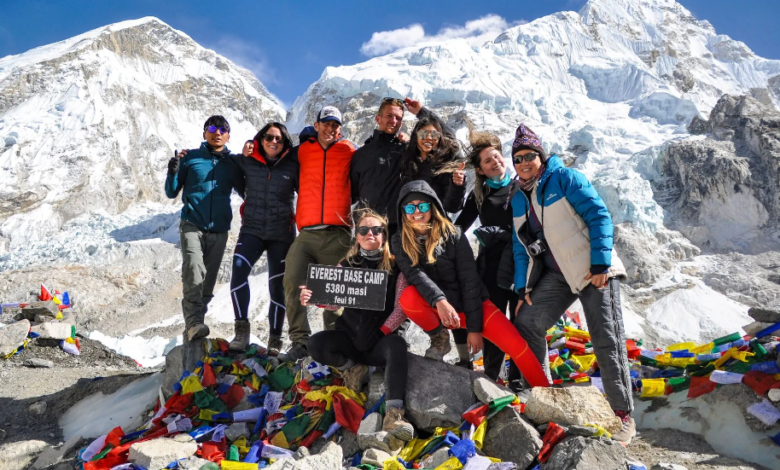How To Handle the Emotional Final Push to Everest Base Camp

Hiking to Everest. What this means for trekkers is a complete immersion in an ecosystem that, while frequented by similar boots clunking on the same stones underfoot, also serves as one of the major transport arteries of the Khumbu Valley. Yaks, dzopkyos (a cross between a yak and cow), and porters are the essential lifeblood of the entire area, carrying everything from your food and fuel to your bags to isolated villages along the Everest Base Camp Trek. None of the members should have any difficulty in walking on these crowded paths! It is very important to maintain safe walking on this physically difficult and narrow route, because you are part of the Mount Everest Base Camp Tour. Backcountry etiquette aside, screwing up a crossover with a heavily laden beast can put you in the emergency room — and your trek to Everest Base Camp on hold.
What about Animals and porters never give way?
On the Khumbu, transport beasts and labour are the mountain’s blue-collar worker, and their crucial role sets their hierarchy upon the trail. In contrast to hiking in many Western nations, the rule on these trails is simple: Animals and porters never give way. They are on a tight schedule, and bearing heavy loads—the Everest Base Camp Trek package is entirely dependent upon them—and it’s the trekkers’ job to get out of their way. When the music of yak bells or yells from a porter sounds rhythmic, be prepared to stop at a safe place. This basic respect for working traffic is the first step to a safe Everest Base Camp Hike.
The Both Sides Rule for Yaks and Dzopkyos
Close encounters with the yaks, and smaller, quicker beasts of burden – the dzopkios, these easily make up the greatest risk on the EBC Trek. These great beasts haul the most unwieldy loads and are commonly steered by rope or a crude hand gesture, now and then proceeding at a pace that shocks. The key safety rule is counterintuitive to what many flat-land hikers might think: always stand on the uphill or wall side of the trail, away from the cliff edge. Yaks and dzopkyos either swing their loads out or give the trail an aggressive hug, and if they nudge you, there’s enough force in there to put you into tumble mode over the drop-off. Never attempt to stroke or approach a working animal, as it is livestock, not a pet, as in the developed wor, they nd are focused on their work.
How to Communicate with Porters – The Call of Nature
Porters The porters, who also carry a whopping amount of weight to assist in managing the Everest base camp trek cost, logistics-wise, are faster, more silent, and may be slightly dangerous due to the speed they have got going for them and the extensive size of their load. They will be announced by a special call, which varies but commonly is “Bistari! (slow) or a loud, piercing exclamation. They made the slightest sound, you stopped right off and shived out of their beat into the clear as far as you could get. They are used to moving around tight spaces with pinpoint precision in the Everest Base Camp Trek distance, but they depend on trekkers clearing the way. “A well-beaten path for a porter is an indication of a responsible and experienced trekker who cares as much for his health as he does for the porters.., The unsung heroes of all EBC treks.”
See also: The Ultimate Guide to URC (Universal Remote Control): Making Life Easier and More Fun
Possible Booby-Traps: Bridges and Chok-choks
And some parts of the Everest Base Camp Itinerary—such as the narrow suspension bridges, crampecorners within ittt and rock-fall zones above Namche Baza,a as well as near Phakding—turn into full-on danger zones when they are laced with grown-up traffic. Never attempt to cross a suspension bridge along with a train of yaks or porters. Wait for the other side to be completely free. If you encounter oncoming traffic as you lead the stolen caravan towards an end that terrible day, be sure to stop long before a squeeze point, and wait like a good thief should. Dodging past a train of yaks on an icy trail doesn’t seem like the kind of EBC Trek Cost that you want to make, whatever your total budget was.
Load Awareness: The Animal and Beyond
A yak is not just the creatur,e but the awkward and many times unbalanced load it carries with it. These loads can be huge pieces of timber, bulky bales of limited supplies being carried out far from the animal’s body. When you stand aside, stay well clear of not just the yak’s body but also the entire width of its load. They also tend to wheel huge boxes stacked to high heaven, sometimes blocking their view off the side. By getting entirely out of the way, you avoid being snagged or pushed by the load and reduce your risk during payment of the Hike to Everest Base Camp cost passage.
The Respectful Photo: Keeping Safety First Over the Snapshot
A train of Yaks crossing a bridge with Everest rising majestically in the background makes for good photographic material.Howeverr do not forget, you need to pick protection over the image. Do no longer stop in the center of the path or method a slender segment to take a image with oncoming site visitors. If you need to document the instant, stand nicely off on a secure, extensive part of the trail. No flash should be used – sudden light can scare the animals and perhaps prompt them to bolt, which endangers both you and your driver, let alone other trekkers. This disciplined approach guarantees that your Mount Everest Base Camp Trek is a respectful cultural journey and not just some tourist spectacle.
The Waiting Game Patience: Part of the Trekking Package
Good things come to those who wait; such is the first requirement of the Everest Base Camp Trek. Oncee in a whi,le the trail turns into clogged up with a wagon educate of fifty yaks or a mile-long line of porters, and you may lose tminutesins due to the fact they’ve precedence. Think of this time as a pressured but welcome spoil, to hydrate, take in the surroundings, and take a look at your tools. This is not only rude but also very dangerous to try and beat or bypass the traffic. Immersing yourself in mountain culture is part of what you sign up for with a luxury Everest Base Camp Trek, and being patient as well as respectful while the world deals with this is an aspect of cultural commitment, irrespective of the balance sheet rregarding theEverest Base Camp Trek Price.
Training and Attitude: Training for the Dynamic Trail
Just as your body is prepared for covering the “distance to Everest base camp“, you should mentally prepare for a changing trail. Practice stepping on and off the ground confidently, trying to stay balanced. Essential is the flexibility to move in and out on a short second take, step aside. As strong legs, a clear head, and a patient attitude on the lower reaches of your hike to Everest base camp.
Final thoughts: Shared responsibility on the road to EBC
The trek to Everest Base Camp is a tourist business done in a working ecosystem, where people live and die according to the flow of goods on four legs. Attack is the best form of defense, and by giving way, sticking to the wall side of the trail and indicating your direction makes it less chance that you would meet an unexpected problem in yourself while safeguarding respect for Sthe herpa community, who do not even realize their pric,e but which keeps all this lonwayys extension moving – Untold Truth about Everest Base Camp Cost inSecretss. It’s a shared responsibility: Your safe trip is on all of us. Learn the trail etiquette,a nd your Everest Base Camp Trek will be a pleasant, enjoyable, and culturally respectful experience from beginning to end.



